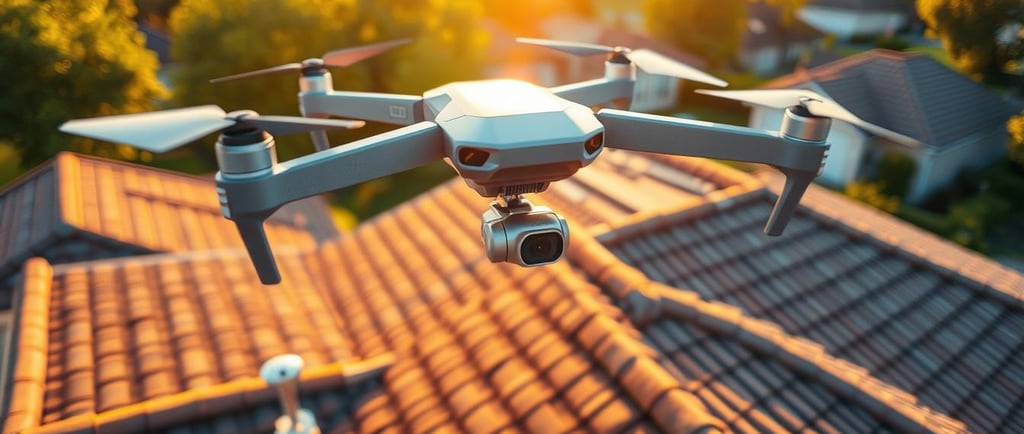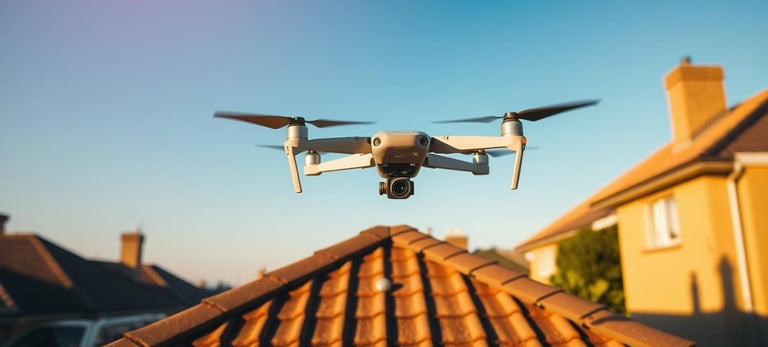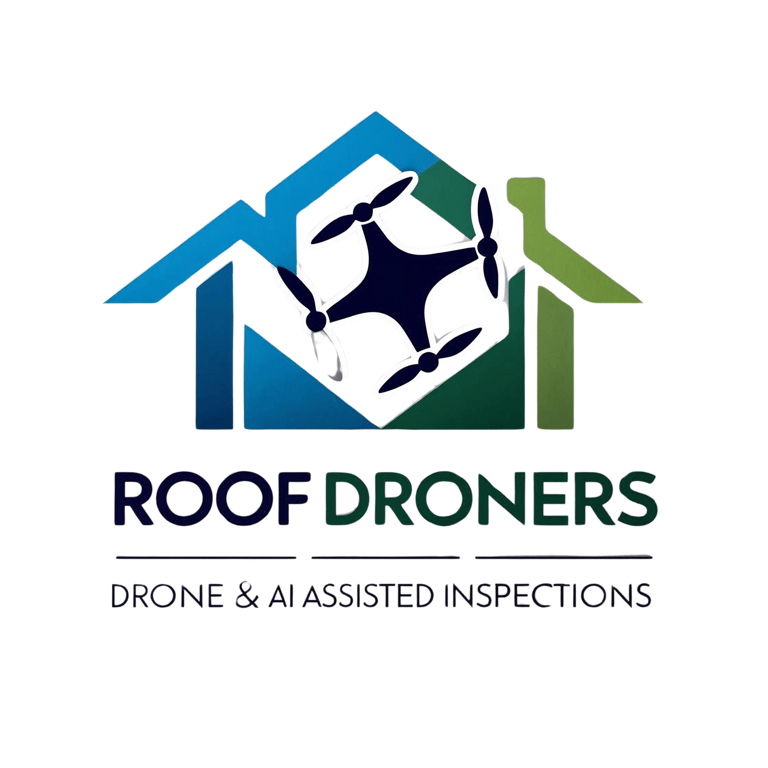The Value of Drone Inspection
The Value of Drone Inspections many property owners and managers are turning to dron inspections when it come to property evaluations
ROOF INSPECTIONS
Roof Droners
2/17/20256 min read


Efficient Drone Roof Inspections for Your Building
Drone pilots can make up to $300 per roof inspection, showing the growing need for drone roof checks in the U.S. This trend is fueled by the many advantages of drones, like quicker inspections, better safety, and lower costs. So, more people like building owners, insurance firms, and maintenance teams are turning to UAV roofing inspections. With the Roof Droners service, you'll pay nothing ( for a limited time)
Thanks to drone tech, roof checks are now quicker, safer, and cheaper. Drones with high-tech cameras and sensors can spot roof issues in detail. This info is key for upkeep, fixes, and insurance needs.
Key Takeaways
Drone roof inspections can reduce inspection time and costs
Aerial roof surveys enhance safety by minimizing the need for personnel to access hazardous areas
UAV roofing inspections provide high-quality images and data for detailed roof assessments
Drone technology allows for faster processing of insurance claims and reduced Loss Adjustment Expenses (LAE)
Drone roof inspections are beneficial for steep-pitched roofs, commercial rooftops, and post-storm checks
Seasonal demand for drone roof inspections goes up during hurricane season, in areas struck by weather
Drone inspections are less invasive, making them easier to schedule than traditional ones
The Evolution of Professional Drone Roof Inspections
Drone roof assessments have changed a lot over time. This is thanks to new tech and a need for better, safer ways to inspect roofs. The market for drone roof inspections is growing fast. It's now worth $9.94 billion and is expected to hit $18.94 billion by 2028.
Drone roof inspections have gotten better with better cameras, more stable flight, and avoiding obstacles. Now, drones like the DJI Air 2S and DJI Mavic 3 can fly up to 7.5 miles and 9.3 miles. These drones can cover big areas quickly and accurately, saving time and money compared to old methods.
Today, drones use artificial intelligence and machine learning to improve their work. They have high-resolution cameras and sensors that provide detailed data, making them key for industries such as construction, insurance, and farming.
Using drones for roof inspections has many benefits. It cuts costs, makes inspections safer, and is more efficient. As drone tech keeps getting better, we'll see even more cool uses for them in roof inspections.
Understanding Modern Drone Technology in Roofing Assessment
Modern drone technology for roof surveys has changed how we do roofing assessments. Drones make it possible to cover large areas quickly, saving time. They use high-resolution cameras to take detailed photos, helping to accurately check the roof's condition.
Drones can reach places that are hard for people to get to. This means they can do thorough checks without being limited by physical barriers. Using drones fits into a bigger trend of making things more digital and automated in building and upkeep. They can spot small problems, like missing shingles or water damage, early on. This saves owners a lot of time and money.
Some main advantages of drone roof inspections are:
Less risk of accidents and injuries
More efficient and accurate
Cost savings by finding problems early
Clearer evidence through visuals
Drones can also have thermal imaging cameras. These cameras can detect heat leaks, moisture, and other hidden issues. This is great for spotting problems before they become major, which can save a lot on repairs and upkeep.
Key Benefits of Aerial Roof Surveys
Aerial roof surveys are safe, cost-effective, and accurate. They use drones to access difficult areas, reducing the risk of accidents and saving money by avoiding the need for scaffolding and ladders.
Drones with thermal sensors can spot water leaks that other methods might miss. They provide real-time feedback, which can make inspections 15% more accurate. Plus, they can take photos in minutes, much faster than traditional methods that take hours.
Reduced inspection time by up to 70%
Improved detection rates by approximately 20%
Enhanced safety, with a reduction in accident risk by over 70%
Increased accessibility, with the ability to inspect hard-to-reach roofs
Detailed reporting, with high-quality images and videos improving clarity and understanding of roof conditions by 40%
Choosing a drone roof inspection company offers many benefits. It saves money, improves safety, and increases accuracy. Aerial drone roof inspections make analysis faster, reducing delays from traditional methods.
Safety Advantages of UAV Roofing Inspections
UAV roofing inspections are safer than old methods. Drones mean no more falls or injuries from ladders. High-resolution cameras on drones let us see everything from the ground. This makes inspections safer and avoids dangers.
Drones can get to spots like chimneys and vents that are hard for people to reach. This cuts down on risks from ladders, which are a big cause of accidents. The main benefits of UAV roofing inspections are:
Reduced risk of falls and injuries
Access to hard-to-reach areas
Minimized ladder-related hazards
UAV roofing inspections are safer and more efficient than old ways. They let drones explore tight spots and gather data safely. This shows how important safety advantages are in UAV roofing inspections.
Cost-Effectiveness of Drone-Based Roof Assessment
Drone-based roof assessment is a cost-effective way for building owners and managers. It cuts down on the need for equipment and people. This makes it cheaper than old methods.
Studies show that traditional roof checks need many people. But, drone checks only need one person. This cuts down labor costs a lot.
Using drones also makes roof checks safer. It can lower accident rates by 50%. This is good for safety and saves money on accidents.
Drone checks also make the planning and proposal process faster. Reports say they can make this part up to 75% faster than old methods.
Some big benefits of drone-based roof assessment are:
Reduced labor costs by up to 50%
Decreased inspection expenses by up to 90%
Increased inspection efficiency by 85%
Improved measurement accuracy, reducing material waste by approximately 10-15%
Companies can save a lot of money and work more efficiently with drone-based roof assessment. It lets them do checks fast and right. As drone tech gets better, we'll see even more ways to save money and stay safe.
Commercial Applications and Industry Uses
Drone roof inspections have many commercial applications and industry uses. They are a valuable tool for different sectors. Drones save businesses money by not needing manual labor. They can cover more ground in one flight, cutting down on inspection time.
Drone roof inspections are used in various industries. They help inspect big places like warehouses and factories. Drones take hundreds of photos, giving a detailed roof condition check. They work well in all weather, perfect for inspections all year.
Some benefits of drone roof inspections include:
Quicker reports from inspections, delivering photographs and videos to clients more rapidly than human inspectors
Lower insurance premiums for property owners, as insurers can assess roofs more accurately and settle claims faster
Cost savings compared to traditional human inspections, reducing the need for multiple specialists
Drone inspections also create detailed 3D models of roofs and areas. This allows for thorough checks and future references. The construction industry is seeing more drone use, showing their growing importance in roof inspections. Drones' high-resolution video, like 4K, improves measurement and assessment accuracy.
Regulatory Compliance and Certification Requirements
Drone roof inspections must follow strict rules and get the right certifications. The Federal Aviation Administration (FAA) is in charge of drones in the U.S. To fly drones for work, like roof checks, you need a Part 107 certification. This gives you a Remote Pilot Certificate.
It's vital to follow these rules to fly drones safely and legally. The FAA often changes its rules, so drone users must keep up. Important parts of following the rules include visual line of sight (VLOS) and geofencing implementation. VLOS means you must always see your drone. Geofencing keeps drones out of no-fly zones.
Getting certified is also key. The Part 107 certification is a must for drone work. It shows you know the safety rules. For thermal checks, you might need a special thermography certification from places like the Infrared Training Center (ITC).
Part 107 certification for commercial drone operators
Visual line of sight (VLOS) during inspections
Geofencing implementation to prevent accidental flights into restricted zones
Thermography certification for thermal inspections
Regular updates on FAA regulations and guidelines
By following these rules and getting the right certifications, drone users can fly safely. This means they can offer top-notch services to their clients.
Data Collection and Reporting Methods
Drone roof inspections use advanced tech to gather data. This includes high-resolution images, videos, and thermal scans. The collected data helps create detailed reports that show roof damage, leaks, and other issues. The data collection process is key to spotting problems early.
The reporting methods in drone roof inspections give clear insights to property owners and facility managers. Reports include detailed images and descriptions of found issues. This allows for quick action to be taken. Regular drone inspections can catch small problems before they grow, keeping the home safe and its value high.
Some key benefits of drone roof inspections are:
Faster inspection times than traditional methods
Lower labor costs
Easy access to complex roofs
High-quality images and videos for detailed analysis
Drone roof inspections are set to get even better with new tech. This includes thermal imaging and AI-driven analysis. As tech advances, data collection and reporting methods will get more efficient. This will give property owners and facility managers even more accurate and detailed insights.
Choosing a Professional Drone Roof Inspection Company
When picking a drone roof inspection company, look at their experience, equipment quality, and service guarantees. A team with lots of experience in aerial roof checks can give you accurate and reliable results. This reduces the chance of missing problems or making expensive mistakes.
Choose a company with top-notch drones and advanced imaging tools like thermal sensors and 4K cameras. Good imagery helps spot issues quickly and well. Also, make sure they offer strong service guarantees, including warranties and support, to protect your investment and give you peace of mind.
By going with a trusted drone roof inspection company, you get the most from aerial roof surveys. This ensures your building's roof stays healthy and strong for a long time. Roof Droners offers a zero-cost roof survey ( for a limited time) Before you pay for an inspection, reach out to us. We would be happy to assist.




